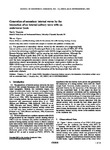Generation of secondary internal waves by the interaction of an internal solitary wave with an underwater bank
| dc.contributor.author | Vlasenko, Vasyl | |
| dc.date.accessioned | 2015-11-29T10:10:25Z | |
| dc.date.available | 2015-11-29T10:10:25Z | |
| dc.date.issued | 2005 | |
| dc.identifier.issn | 0148-0227 | |
| dc.identifier.issn | 2169-9291 | |
| dc.identifier.other | C02019 | |
| dc.identifier.uri | http://hdl.handle.net/10026.1/3858 | |
| dc.description.abstract |
The generation of secondary internal waves by the interaction of a large-amplitude internal solitary wave with the Dreadnought Bank in the Andaman Sea (6°40′N, 95° 47′E) is shown by analyzing a synthetic aperture radar (SAR) image acquired by the European Remote Sensing satellite ERS-2 and by carrying out model calculations. Although the Dreadnought Bank is quite deep (241 m), the model calculations show that large-amplitude internal solitary waves as encountered in this sea area can overturn and break over the bank and generate secondary internal waves. Comparison of model results with observations clearly demonstrates that the semicircular wave pattern visible on the ERS-2 SAR image centered at the Dreadnought Bank is indeed a sea surface manifestation of a secondary internal wave packet generated by scattering of a large-amplitude internal solitary wave and not by the interaction of the barotropic tidal flux with this underwater obstacle. Copyright 2005 by the American Geophysical Union. | |
| dc.format.extent | 1-16 | |
| dc.language | en | |
| dc.language.iso | en | |
| dc.publisher | American Geophysical Union (AGU) | |
| dc.title | Generation of secondary internal waves by the interaction of an internal solitary wave with an underwater bank | |
| dc.type | journal-article | |
| dc.type | Journal Article | |
| plymouth.author-url | https://www.webofscience.com/api/gateway?GWVersion=2&SrcApp=PARTNER_APP&SrcAuth=LinksAMR&KeyUT=WOS:000227527000006&DestLinkType=FullRecord&DestApp=ALL_WOS&UsrCustomerID=11bb513d99f797142bcfeffcc58ea008 | |
| plymouth.issue | C2 | |
| plymouth.volume | 110 | |
| plymouth.publication-status | Published | |
| plymouth.journal | Journal of Geophysical Research | |
| dc.identifier.doi | 10.1029/2004jc002467 | |
| plymouth.organisational-group | /Plymouth | |
| plymouth.organisational-group | /Plymouth/Faculty of Science and Engineering | |
| plymouth.organisational-group | /Plymouth/Faculty of Science and Engineering/School of Biological and Marine Sciences | |
| plymouth.organisational-group | /Plymouth/REF 2021 Researchers by UoA | |
| plymouth.organisational-group | /Plymouth/REF 2021 Researchers by UoA/UoA07 Earth Systems and Environmental Sciences | |
| plymouth.organisational-group | /Plymouth/Research Groups | |
| plymouth.organisational-group | /Plymouth/Research Groups/Marine Institute | |
| plymouth.organisational-group | /Plymouth/Users by role | |
| plymouth.organisational-group | /Plymouth/Users by role/Academics | |
| dc.identifier.eissn | 2169-9291 | |
| dc.rights.embargoperiod | No embargo | |
| rioxxterms.versionofrecord | 10.1029/2004jc002467 | |
| rioxxterms.licenseref.uri | http://www.rioxx.net/licenses/all-rights-reserved | |
| rioxxterms.type | Journal Article/Review |


